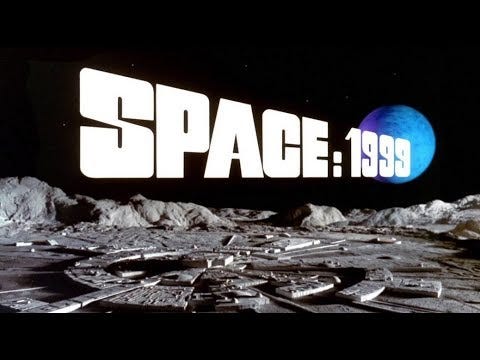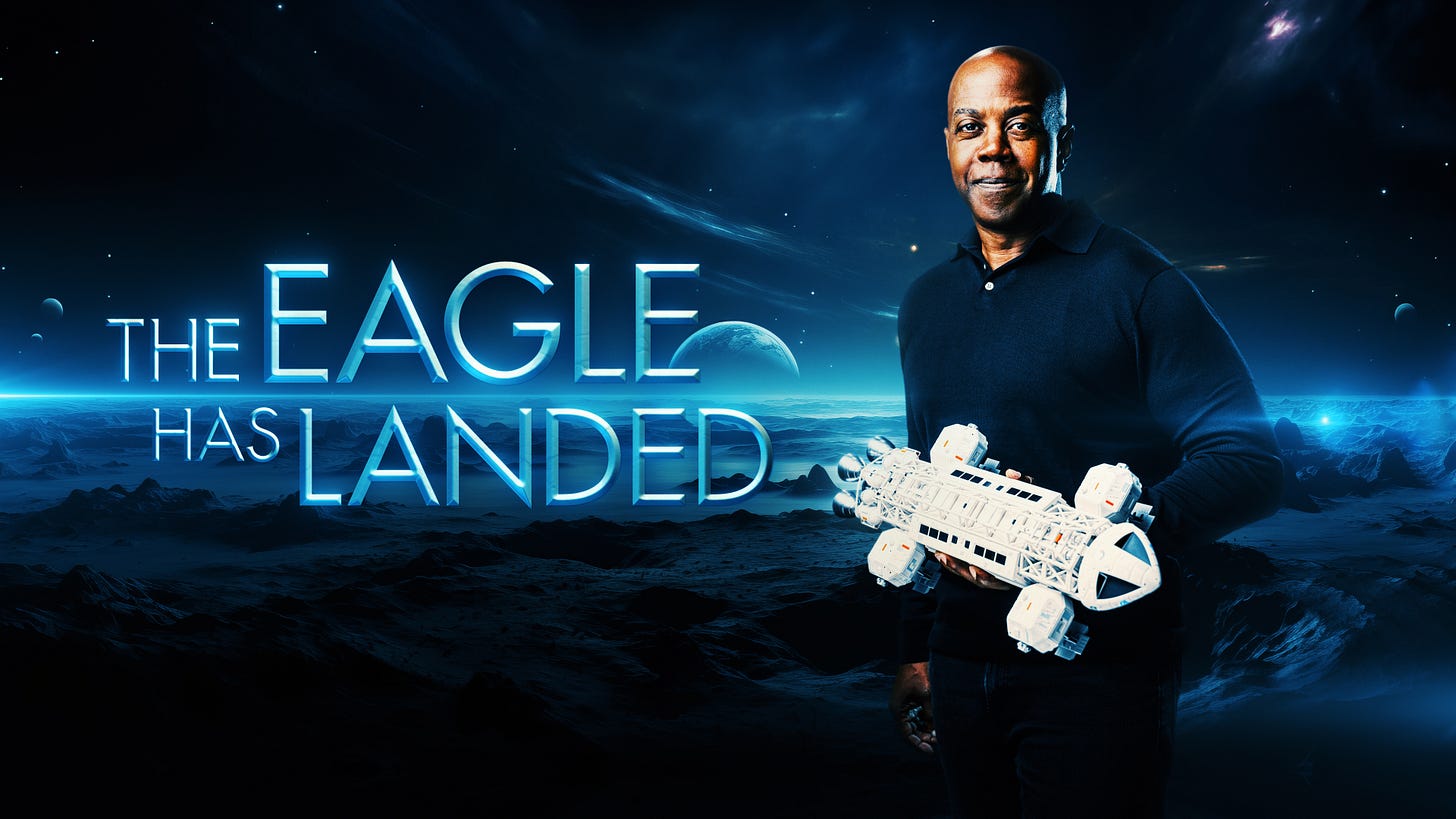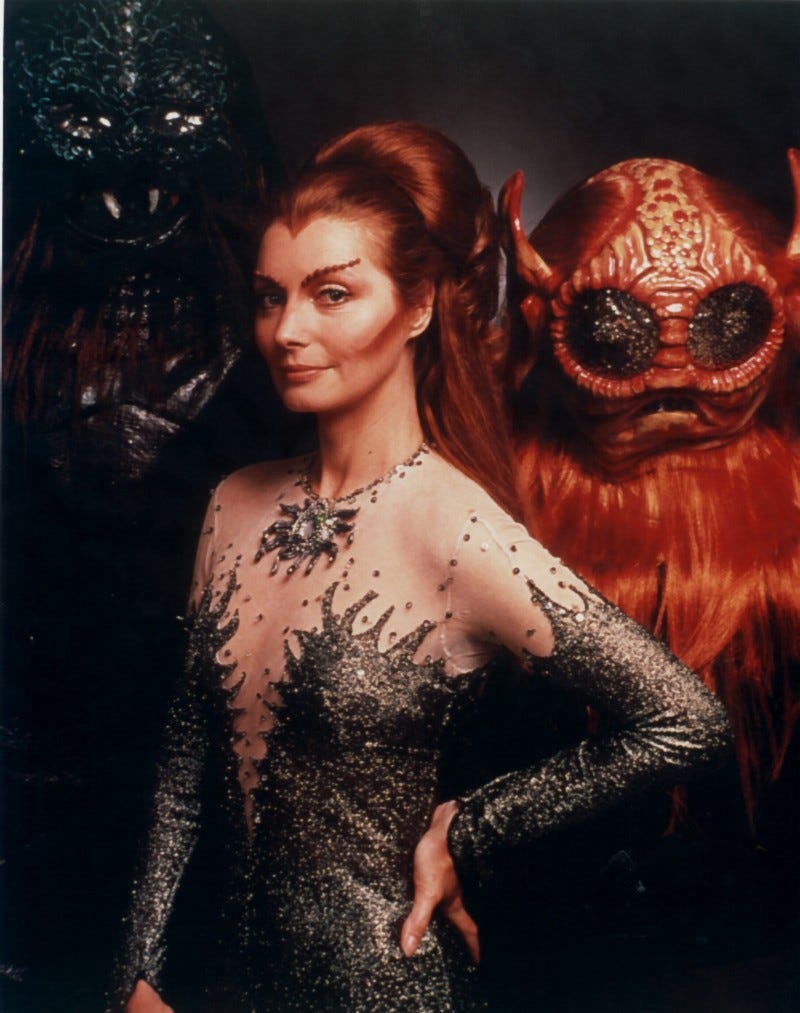Welcome to Star Trekking — random intersections in the final frontier.
And sometimes the final frontier intersects with the moon.
September 13, 1999. The moon is blasted out of earth’s orbit, hurling Moonbase Alpha into the void.
For those of us growing up in the long interregnum between the cancellation of Star Trek and its resurrection on the big screen, Space: 1999 served as a weird stopgap, a possible replacement for our need to see weekly space adventures.
It was only partially successful. Often derided by critics and fans alike (especially the second season for which this reporter still retains an inexplicable fondness) the show nevertheless left a cultural imprint that continues to resonate in the minds of many science fiction fans - an imprint in the shape of a spacecraft:
The Eagle.
At the time, it seemed like the perfect projection of Apollo-era spacecraft into that distant future that was the year 1999. I owned several Eagle models as well as the Dinky version of the craft (on display in my office right now).
So when I saw that Jeffrey Morris (aka FutureDude) was launching a Kickstarter for a documentary called The Eagle Has Landed, well, I had to find out more.
INTERVIEW WITH JEFFREY MORRIS
First, tell us a little about yourself.
I’m a writer, director, and production designer focused primarily on the creation of hard-sci-fi tales. I’m known for the graphic novel and animated short film Parallel Man, which stars John Cho, Ming-Na Wen and the late Lance Reddick. I’m also the creator of the underwater adventure Oceanus: Act One. I like plausibility in my science fiction. I live by what I call the 85% rule where I try to set the level of plausible science, technology, and physics in my stories to be around 85% realistic, while leaving the remaining 15% for the fun bits. I was most inspired by Star Trek creator Gene Roddenberry, Astronomer Carl Sagan, and Visual Futurist Syd Mead.
I want to bring back the vibe of speculative tales made in the late 60’s and early 70’s. The era before Star Wars-style storytelling (which I consider to be "space fantasy” as opposed to science fiction) — but with today’s technology and pacing. My feature film project Persephone is set on the real, and potentially-habitable, world of Proxima b (which orbits the nearest star—aside from the Sun of course!). It’s an adventure tale that deals with what happens when settlers from Earth arrive in the 22nd Century to discover that their remotely-established colony is in jeopardy from something on the planet they didn’t expect. How they learn about and deal with this unexpected “threat” is the crux of the narrative. I want to tell human stories against the backdrop of a quasi-realistic future setting.
Listed below are a few links for you so you can see some of my work:
What are your first memories of Space: 1999?
I spent my childhood in Tempe, Arizona. I was a kid (seven at the time) who was deeply enthralled by the Apollo program and always seeking out anything about space that I could get my hands on. At the time I was determined to be an astronaut and GO TO THE MOON! I saw a Fall TV preview on the local NBC affiliate that was showcasing upcoming shows. There was a teaser for a show called SPACE: 1999 and I freaked out. The thing that struck me the most in the video was the Eagle. From that point forward, I was desperate to watch it. The first episode, “Breakaway” blew my mind. I loved the base and the tech and characters. I was totally in. While I may have been a kid, I totally got it.
Like me, I suspect you were drawn to the "realism" of the Eagle. Arriving as they did in the mid seventies, they felt like actual descendants of the lunar spacecraft we'd witnessed in action.
I could not agree more. The elements of real spacecraft like the LEM and Apollo CSM were present in the Eagle-like RCS thrusters and rear engines that felt reminiscent of the Saturn V. It felt connected to the time as a seemingly-realistic projection into the future.
What is it about the Eagles that have continued to resonate in the SF community as well as the culture at large?
First off, I think the design is timeless and perfectly balanced from an aesthetic standpoint. It also feels tangible and connected to reality. That makes it a standout among most sci-fi spacecraft. Typical designs are going for flash and appeal as opposed to realism. More importantly, I think its staying power stems from the fact that those of us who grew up playing with Eagle toys felt like they were from OUR future—a world we were going to grow up and live in a few decades ahead in time. Unfortunately, that futuristic world of Eagles and Moonbases and space stations never came to pass. I think we lost a dream of tomorrow and have been looking for it ever since. the Eagle represents the lost future we all wish we could have lived in. Most of us can’t let it go.
Those of us who grew up playing with Eagle toys felt like they were from OUR future—a world we were going to grow up and live in a few decades ahead in time. Unfortunately, that futuristic world of Eagles and Moonbases and space stations never came to pass. I think we lost a dream of tomorrow and have been looking for it ever since.
As a Star Trek related newsletter, I feel I need to ask you - what has been your experience with Star Trek?
Star Trek has been deeply impactful to me and my life. I watched The Original Series virtually every single day of my childhood and I was deeply enamored with The Animated Series. The future represented in that series reflected the world that I wanted to live in—especially from a diversity standpoint. For me personally, The Next Generation is the apex of science fiction television. It’s never gotten better than that. I also love Deep Space Nine. I think the intelligence and optimism of classic Trek adventures is so important and has had an everlasting impact on our society.
Tell us about the Trek alums involved in your project.
I’m honored to be interviewing award-winning Trek artists Michael and Denise Okuda who are both fans of Space: 1999. Michael and I have had numerous conversations about the connection between NASA hardware and the Eagle. He even keeps models of both next to each other on a shelf behind his desk! I also have the opportunity to interview visual effects supervision Bill George. He’s worked on numerous Trek films and is even credited with designing the U.S.S. Excelsior—one of my favorite Trek ships. I’m also going to be chatting with Robert Meyer Burnett, Daren Dochterman, and Jeff Bond—all of whom have significant connections to the world of Star Trek in their own fascinating and memorable ways. In addition, they are all huge Eagle fans and collectors.
Your film is not intended to be a documentary about Space: 1999 per se, but about the Eagle itself. How did you decide to put this project together? What attracted you to making a film about a TV spaceship?
Yes. It’s not really a story about 1999. It’s much more about the continuing impact of the Eagle itself. While I am a collector of various sci-fi models and toys (including numerous pieces of Star Trek memorabilia), the Eagle has always been my absolute favorite. I keep running into people around the world who shared the same interest and love. There’s even a man in Denmark who built a 1/4 scale Eagle in his own back yard recently. I had to explore and understand the roots of this obsession. That’s what the documentary is all about.
Finally, tell us a little about the Kickstarter.
It launches on Wednesday, September 13th—which is known as “Breakaway Day” in Space: 1999 lore. Our goal is to raise a minimum of $500,000. However, there are some very cool Stretch Goals that include creating new visual effects, a virtual tour of the Eagle, and building a full-scale mock of of the interior that fans could tour. We would love the support of your readers. Plus they will get to hear from many cool Trek alumni.
As for why I’m doing this as a Kickstarter, I pitched the documentary to several major entertainment outlets. And while there was interest, they all wanted me to focus solely on celebrities only and basically forget the fan angle. I just didn’t think that was the point. I want to tell the real story of the Eagle from the standpoint of those who love it—celebrity or every day fan. Financing it through Kickstarter allows me to maintain creative control and tell the story I want to tell. I’m tired of Hollywood gatekeepers. I just don’t think most of them understand what fans want to see.
Thanks, Jeffrey!
The Eagle Has Landed Kickstarter launches today. You can find out more about Jeffrey and the project at eagledocumentary.com.
Follow FutureDude Entertainment on Instagram and Facebook.
Please consider joining me as a contributor. The world needs more documentaries about the awesome spacecraft of our youth!
Okay, fine, yes, this is one of the main reasons I still love the terrible second season of Space: 1999.
I also enjoyed reading her book.
Don’t worry, I am not (yet) pivoting away from Star Trek content. After all, the human adventure is just beginning - in my heart.








Oh my goodness, how the heck could I forget about Sept. 13? This is a well deserved reminder, love this post and Space: 1999 and I'm really intrigued by the Kickstarter.
For those who don't know about Space: 1999: in an alternate timeline, Earth's Moon left its orbit and started travelling solo around the universe 24 years ago today!